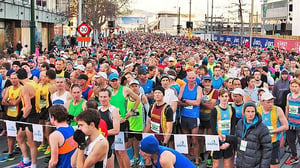The Christchurch Marathon - New Zealand
Before 2011, The Christchurch Marathon was a popular event with runners travelling from around the country to take part in a day known for its goodwill and companionship among participants. However, when a devastating earthquake struck the city in 2011, the marathon was a part of city life that seemed lost for good.
With the support of a strong community, volunteer work, and the goodwill of the Christchurch Airport, the event was recreated for the next four years around the airport site.

"There is a need for really reliable communications, there is risk there of something happening to runners or spectators, and the implications that has for the event's reputation as an enjoyable, popular and most of all safe occasion."
Situation
In order to get the popular running event back on its feet, organisers required a rock solid communications system for safety and smooth operation. After four years, post-quake Christchurch's streets still prove a challenge for race organisers, with plenty of congestion points, diversions, and difficult surfaces.
Over the past few years, race organisers have called on local firm Outback Communications to ensure the experience and equipment is available to keep communications for the sprawling event coming through loud and clear.
As the communications provider, the challenge for Outback director Corey Weir was to ensure complete coverage around the course, with the ability to access emergency services, including Police and St Johns when necessary.
A robust network within the event is also needed for communications between marshals, race control, and the assorted lead/following vehicles employed around the course.
Solution
Outback Communications rented Tait Communications products to provide their network.
The network allowed marshals and race controller, Dave Watson, to remain linked and in communication range of each other at the start and finish line. While St Johns Emergency Services had its own network, the interoperable Tait radios could tune into their network in the event of an emergency.
Private conversations could be held between Control and race marshals, with field communications maintained on another channel. Weir also made sure all the radios were logged onto a laptop, where conversations would be recorded in the event of an incident.
"It is the sort of event where we have had times when Emergency services are required, particularly last year when we had a runner who experienced cardiac arrest." explained Watson.
This year's marathon was the first time organisers tagged some runners and key mobile marshals with GPS tags. The Crosswire GPS personal tracking system gave organisers a clear picture of how the race was progressing, and allowed spectators to log in and see where specific runners were positioned in the race.
Overall, the event included 50 Tait TP8110 hand held radios in the field, using a combination of both repeater and simplex channels. While the event has a core of dedicated volunteers who return most years, the simplicity of the analogue Tait TP8110 radios made them ideal for people who rarely handle two-way radios.
"It is a tried and proven technology that fits well with this sort of situation."
Response
Locals and runners welcomed the marathon's return to the central city, with a surge in numbers and huge support from spectator crowds around the accessible course. A key part of the marathon's successful re-birth was the smooth operation and the "runner friendly" approach of management and volunteers involved in operating the big event.
Watson said of Outback Communications, "We have found every year the communications gets better and better."
Race director Chris Cox attributed the smooth-running of the event to the Tait radio communication products supplied to them, stating that the radios improved communications hugely in an environment where they have to be in a position know exactly how a race is unfolding. The excellent battery life along with the headsets that the radios were equipped with proved invaluable in delivering clearer voice communications. They were ideal for the team leaders on motorbikes and bicycles traversing the course in constant communications with race control. Reliable and flexible communications definitely kept the marathon on track.